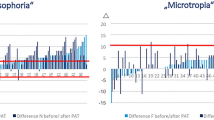Abstract
Purpose
To assess the effects of prism adaptation on the surgical outcomes of individuals with partially accommodative esotropia (PAET).
Methods
The medical records of 51 patients with PAET who were managed surgically at single referral center were retrospectively reviewed. Patients were divided into two groups according to prism adaptation. Data about sex, age, initial angle of deviation, final angle of deviation, stereoacuity, surgical dosage, and follow-up periods were collected. The main outcome of this study was motor outcomes at 12 months.
Results
Eighteen patients had a history of prism adaptation (PA group) and 33 did not (augmented surgery group, AS group). One year after surgery, 12 (66.7%) patients in the PA group and 21 (63.6%) in the AS group achieved an angle of deviation less than 5 PD. The surgical success rate in both groups did not significantly differ (p = 1). After the first prism adaptation test, six patients had an angle of deviation similar to the previous angle; however, 12 patients had larger angle, and consequently required additional prism (prism builder). Two (33.3%) patients who were prism non-builders had deviation less than 5 PD during the final visit. However, among the prism builders, four (57.1%) and five (100%) patients who had prism added once and more than once, respectively, had less than 5 PD deviation during the final visit (p = 0.03).
Conclusion
No significant differences were observed in terms of surgical outcomes between both groups. Nonetheless, in PA group, prism builders have better surgical outcomes than non-builders.
Similar content being viewed by others
Data availability
Not applicable.
References
Scott WE, Thalacker JA (1984) Preoperative prism adaptation in acquired esotropia. Ophthalmologica 189:49–53
Wright KW, Bruce-Lyle L (1993) Augmented surgery for esotropia associated with high hypermetropia. J Pediatr Ophthalmol Strabismus 30:167–170
Repka MX, Connett JE, Scott WE (1996) The one-year surgical outcome after prism adaptation for the management of acquired esotropia. Ophthalmology 103:922–928
Repka MX, Wentworth D (1991) Predictors of prism response during prism adaptation. Prism Adaptation Study Research Group J Pediatr Ophthalmol Strabismus 28:202–205
Jotterand VH, Isenberg SJ (1988) Enhancing surgery for acquired esotropia. Ophthalmic Surg 19:263–266
Hwang JM, Min BM, Park SC, Oh SY, Sung NK (2001) A randomized comparison of prism adaptation and augmented surgery in the surgical management of esotropia associated with hypermetropia: one-year surgical outcomes. J AAPOS 5:31–34
Greenberg AE, Mohney BG, Diehl NN, Burke JP (2007) Incidence and types of childhood esotropia: a population-based study. Ophthalmology 114:170–174
Parks MM, Mitchell PR, Wheeler MB (2002) Duane’s foundations of clinical ophthalmology. Lippincott Williams and Wilkins, Philadelphia, PA
Repka MX, Connett JE, Baker JD, Rosenbaum AL (1992) Surgery in the prism adaptation study: accuracy and dose response. Prism Adaptation Study Research Group. J Pediatr Ophthalmol Strabismus 29:150–156
Hwang JM, Min BM, Park SC, Oh SY (1999) A randomized comparison of prism adaptation and augmented surgery in the surgical management of esotropia associated with hypermetropia. J Pediatr Ophthalmol Strabismus 36:196–200
Kushner BJ (1995) Partly accommodative esotropia. Should you overcorrect and cut the plus? Arch Ophthalmol 113:1530–1534
Arnoldi K (2002) Long-term surgical outcome of partially accommodative esotropia. Am Orthopt J 52:75–84
Akar S, Gokyigit B, Sayin N, Demirok A, Yilmaz OF (2013) Medial rectus Faden operations with or without recession for partially accommodative esotropia associated with a high accommodative convergence to accommodation ratio. Br J Ophthalmol 97:83–87
Quigley C, Cairns M, McElnea E, Doyle F, McCance J, Mullaney P (2017) A retrospective evaluation of bilateral medial rectus recession for management of accommodative esotropia according to prism-adapted motor response preoperatively. J AAPOS 21:157-159.e151
Jiang D, Han D, Zhang J, Pei T, Zhao Q (2018) Clinical study of the influence of preoperative wearing time on postoperative effects in children with partially accommodative esotropia. Medicine 97:e0619
Mohan K, Sharma SK (2018) Long-term motor and sensory outcomes after surgery for the nonaccommodative component of partially refractive accommodative esotropia. J AAPOS 22:356–360
Arnoldi K, Shainberg M (2005) High AC/a ET: bifocals? Surgery? Or nothing at all? Am J Orthop 55:62–75
Lueder GT, Norman AA (2006) Strabismus surgery for elimination of bifocals in accommodative esotropia. Am J Ophthalmol 142:632–635
Burke JP (2015) Distance-near disparity esotropia: can we shrink the gap? Eye (Lond) 29:208–213
Wong AM, Lueder GT, Burkhalter A, Tychsen L (2000) Anomalous retinal correspondence: neuroanatomic mechanism in strabismic monkeys and clinical findings in strabismic children. J AAPOS 4:168–174
Savino G, Abed E, Rebecchi MT, Spreca M, Tredici C, Dickmann A (2016) Acute acquired concomitant esotropia and decompensated monofixation syndrome: a sensory-motor status assessment. Can J Ophthalmol 51:258–264
Funding
This research was supported by the National Research Foundation of Korea (NRF) Grant funded by the Korean Government (MOE) (No. 2017R1D1A1B03032985). The grant had no role in the design or conduct of this research.
Author information
Authors and Affiliations
Corresponding author
Ethics declarations
Conflict of interest
The authors declare that they have no conflict of interest.
Ethics approval
All procedures performed in studies involving human participants were in accordance with the ethical standards of the institutional and/or national research committee and with the Helsinki declaration and its later amendments or comparable ethical standards.
Consent to participate/consent for publication
For this type of study, formal consent is not required. The Institutional Review Board of Seoul National University Hospital in South Korea granted a waiver of consent for this retrospective chart review study.
Code availability
Not applicable.
Additional information
Publisher’s note
Springer Nature remains neutral with regard to jurisdictional claims in published maps and institutional affiliations.
Rights and permissions
About this article
Cite this article
Jang, Y., Lee, HJ., Jung, J.H. et al. Effect of prism adaptation in patients with partially accommodative esotropia: clinical findings and surgical outcomes. Graefes Arch Clin Exp Ophthalmol 259, 223–229 (2021). https://doi.org/10.1007/s00417-020-04902-6
Received:
Revised:
Accepted:
Published:
Issue Date:
DOI: https://doi.org/10.1007/s00417-020-04902-6




